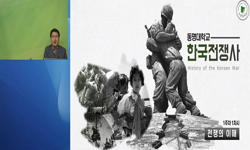본연구에서는이청준소설에나타난한국전쟁의원체험과그재구성의 변주를고찰하였다. 이청준은 한국전쟁을 유년기에 체험한 작가로서, 그의 문학에는 전쟁이라는 폭력적 상황과 그에 대한 ...
http://chineseinput.net/에서 pinyin(병음)방식으로 중국어를 변환할 수 있습니다.
변환된 중국어를 복사하여 사용하시면 됩니다.
- 中文 을 입력하시려면 zhongwen을 입력하시고 space를누르시면됩니다.
- 北京 을 입력하시려면 beijing을 입력하시고 space를 누르시면 됩니다.

한국전쟁의 원체험과 재구(再構)의 변주 = Original experience of Korean War and Variation of Reconstruction - focusing on Lee Cheong-jun's novels
한글로보기https://www.riss.kr/link?id=A101941542
- 저자
- 발행기관
- 학술지명
- 권호사항
-
발행연도
2016
-
작성언어
-
- 주제어
-
KDC
810.5
-
등재정보
KCI등재
-
자료형태
학술저널
- 발행기관 URL
-
수록면
213-239(27쪽)
- DOI식별코드
- 제공처
- 소장기관
-
0
상세조회 -
0
다운로드
부가정보
국문 초록 (Abstract)
본연구에서는이청준소설에나타난한국전쟁의원체험과그재구성의 변주를고찰하였다. 이청준은 한국전쟁을 유년기에 체험한 작가로서, 그의 문학에는 전쟁이라는 폭력적 상황과 그에 대한 공포가 음화로 남아 있다. 이러한 전쟁의 상처가 소설 속에서 ‘전짓불’모티프 등으로 변주되며 이청준 소설의 중요한 근간을 이루고 있다는 점은 널리 알려진사실이다. 이 논문에서는 이청준 소설 중 한국전쟁의 체험을 직, 간접적으로 드러내고 있는 초기 작품부터 후기 작품까지를 통시적으로 분석함으로써 한국전쟁의 기억이 시대에 따라 어떻게 형상화되고 있으며, 그에 대한 인식이 어떻게 변모하는지를 고찰하였다.
초기작인 병신과 머저리 는 한국전쟁이남긴보이지않는상처를 다룬 소설로서전쟁체험 세대인 형과 어린 시절 전쟁을 겪은 동생의 상처를 대비하여 보여준다. 작가는 전쟁의 상처가 명확한 형과는 달리 명확한 상처를 알 수 없는 동생의 서사를 통해 유년기 전쟁 체험 세대에 대한 성찰을 시도한다. 또한 이청준은 소문의 벽 과 씌어지지 않은 자서전 등의 소설을 통해 1970년대 억압적인 사회를 비판적으로 그려낸다. 이 작품들에서는 어린 시절 한국전쟁 시기에 겪은 ‘전짓불’ 모티프가 반복적으로 나타나는데, 이청준은 전짓불 모티프의 반복을 통해 전쟁 시기의 폭력성이 억압적인 사회에서 여전히 계속되고
있음을 고발한다. 즉, 이청준은 어린 시절 최초로 경험한 충격적 사건인 6․25의 원체험을 그 시대의 억압적 상황으로 변주고 있는 것이다. 이청준은 1990년대에 비로소 구체적인 한국전쟁의 문제, 즉 과거 폭력적 이념대립의 기억을 복원하고 그 갈등의 청산 문제에 접근한다. 가해자의 얼굴 , 흰옷, 지하실 등의 작품에서는 어쩔 수 없이 가해자와 피해자로 나뉘었던 전쟁의 기억을 떠올리며 그 기억을 통해 화해를 모색하고자 한다. 그는후기소설에서비로소유년기에겪은전쟁체험의기억을다시재구성함으로써그때의 갈등을 풀어내는 것이다.
이청준은초기소설에서어린시절한국전쟁을체험한세대에대한세대의식을보여주었다면, 중기 소설에서는 전쟁의 폭압적 상황을 당대의 억압적 사회 현실과 연결시킨다.
초기, 중기 소설에서는 한국전쟁의 충격적 기억을 제대로 재현해낸다기보다는 그때의 상황적 폭력성을 상징적으로 변주해낸다고 할 수 있다. 그러나 후기소설에서는 잊으려 했던 유년기에겪은폭력적상황과마주함으로써그때의대립과반목이낳은상처를용서와화해로 극복하고자 한다. 그는 과거의 고통스러운 기억을 복원함으로써 그 상처를 치유하는 것이 전쟁의 상처를 다음 세대에게 남겨주지 않는 일이며, 그것이 전쟁을 체험한 마지막세대로서의 사명임을 말한다. 또한 이러한 한국전쟁의 원체험과 재구의 과정은 사회와 개인의 관계에 천착한 이청준 소설이 그 주제의 깊이를 더해가는 과정을 보여준다 하겠다.
다국어 초록 (Multilingual Abstract)
This study examined Lee Cheong-jun's literature, focusing on key word Korean War. It inquired into how shape is given to the memory of Korean War over time and how an understanding of this changed by analyzing works that directly and indirectly reveal...
This study examined Lee Cheong-jun's literature, focusing on key word Korean War. It inquired into how shape is given to the memory of Korean War over time and how an understanding of this changed by analyzing works that directly and indirectly revealed the experience of Korean War in Lee Cheong-jun's novels. Lee Cheong-jun is an author who experienced Korean war in his childhood. And horror of war remains as severe trauma in his literature. The scars of war in his childhood repeatedly play a variation in many novels of Lee.
His early work The Wounded is a novel that deals with invisible scars left by Korean War. This work shows scars on elder brother belonging to generation that experienced the war and younger brother belonging to generation that didn't directly experience the war. The author tries to reflect on his generation through a narrative given by the
younger brother who cannot know a definite scar, differently from the elder brother for whom the scars of war are definite.
Besides, Lee Cheong-jun critically depicts the oppressive society in the 1970s through the novels such as The Wall of Rumor and An Unwritten Autobiography. The motif of 'electric light' experienced in
the Korean War in his childhood is repeatedly shown in these works. Lee accuses the suppressive society of still continuing the violence in times of war through the repeat of electric light motif. That is to say, Lee
Cheong-jun plays a variation on the original experience of Korean war(also known as 6․25), shock which he first experienced in his childhood, as suppressive situation at that time.
Lee Cheong-jun approaches a specific KoreanWar issue, i.e., ideological confrontation and reconciliation issue for the first time in the 1990s. In the works such as Assailant's Face , White Clothes and The basement , he recalls the memory of war where people are forced to be divided into assailants and victims, and intends to grope for reconciliation through the memory. In his later novels, he reconstructs the memory of war experience in his childhood, and resolves conflicts at that time. He says that not leaving the scars of war the next generation through
forgiveness and reconciliation is a task assigned to the generation who experienced the war.
목차 (Table of Contents)
- 1. 들어가는 글
- 2. 전쟁 체험과 세대의식
- 3. 공포의 내면화와 시대적 변주
- 4. 기억의 재구와 소산의 윤리
- 5. 나가는 글
- 1. 들어가는 글
- 2. 전쟁 체험과 세대의식
- 3. 공포의 내면화와 시대적 변주
- 4. 기억의 재구와 소산의 윤리
- 5. 나가는 글
동일학술지(권/호) 다른 논문
-
- 어문연구학회
- 송미영(Song Mi-young)
- 2016
- KCI등재
-
- 어문연구학회
- 유경민(Yu Kyung-min)
- 2016
- KCI등재
-
- 어문연구학회
- 이숙의(Lee Suk-eui)
- 2016
- KCI등재
-
- 어문연구학회
- 강동석(Kang Dong-seok)
- 2016
- KCI등재





 KCI
KCI 스콜라
스콜라







